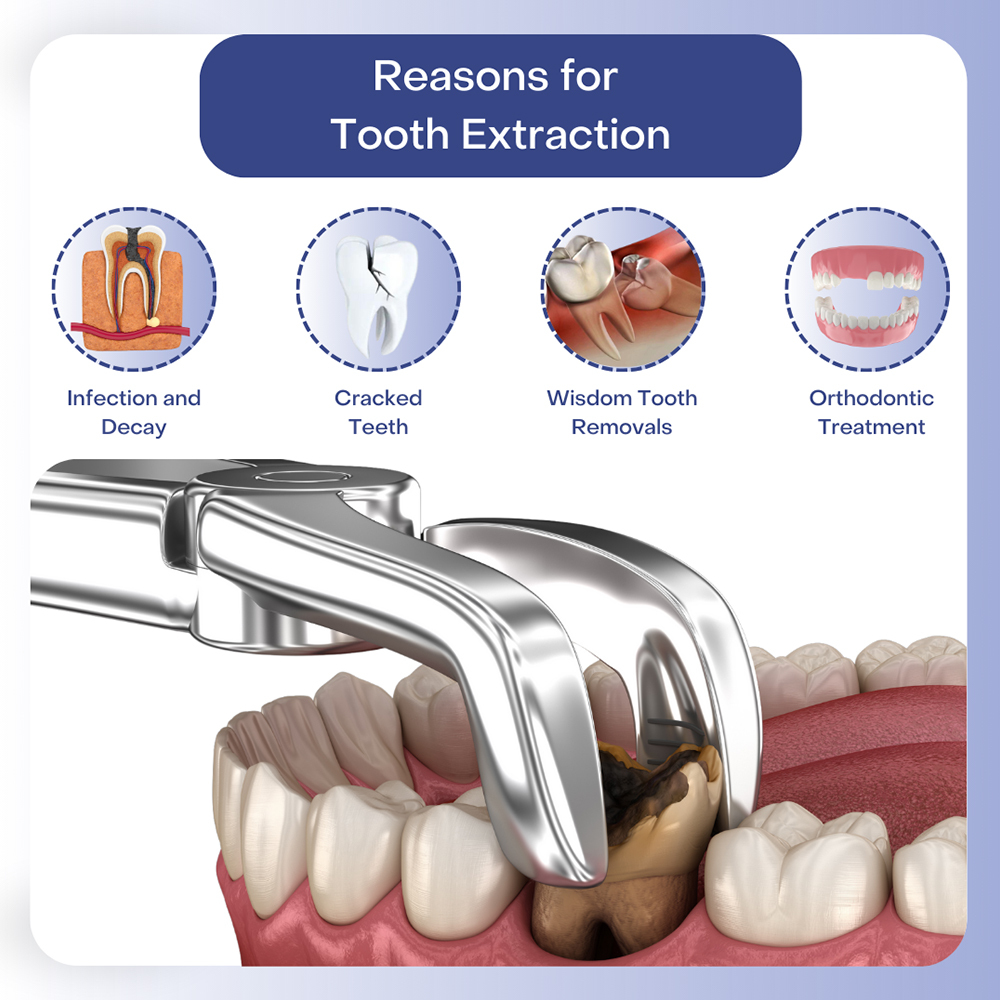Table of contents
 We may suggest a tooth is removed for several reasons, including the following.
We may suggest a tooth is removed for several reasons, including the following.
Usually, teeth need to be removed if they have lost much of their original structure due to tooth decay or are severely infected and cannot be restored. Removing the tooth gets rid of the infection, relieving discomfort and pain and preventing further damage to the tissues surrounding the tooth, including the gum and bone.
Sometimes, a tooth will lose most of its original structure above the gumline, so there is inadequate tooth left to restore. This can occur because of trauma to the tooth.
Other times, a tooth may split vertically down its tooth root. When a tooth cracks vertically through the root, it cannot usually be restored. Extraction may be the only viable option if you have a severely broken tooth.
Impacted or partially erupted wisdom teeth can cause problems and must be extracted. They frequently cause problems because they are the last teeth to erupt when all the adult teeth are already in position and have taken up most or all of the room in the jawbone.
Consequently, wisdom teeth can come through sideways or underneath the adjacent teeth or will partially emerge, remaining partly covered with gum. Partly erupted or impacted wisdom teeth can affect the nearby teeth and cause problems with infection and decay.
Sometimes, teeth must be removed as part of an orthodontic treatment plan, creating enough room for your remaining teeth to be moved into the proper positions.
Some people find their baby teeth do not fall out naturally at the right time. In this case, they must be removed so the adult teeth can come through properly.
Initially, we will examine the tooth and x-ray it. The x-ray enables us to assess the condition of the tooth root to see any hidden signs of infection and decay and see if the tooth can be saved.
Once we have assessed the tooth, we can talk through your options. If we think there is a reasonable chance of saving your tooth, we will always encourage you to consider this treatment carefully. However, sometimes it is very clear a tooth cannot be saved.
What If I Need an Emergency Tooth Extraction?
Many tooth extractions can be planned and are not a dental emergency. However, if you have a severely infected tooth that cannot be saved with root canal therapy, it may need an emergency tooth extraction.
Emergency tooth removal is necessary if a tooth is abscessed, as this is a severe infection that is most likely extremely painful. A dental abscess is caused when the infection spreads beyond the tooth roots and into the surrounding tissues. It can result in a buildup of pus on the gum nearest the affected tooth. In the worst case, it can begin to make you feel very ill.
You must seek emergency dental care if an infected tooth makes you feel unwell or feverish or has caused facial swelling. There is a risk that it could become life-threatening when the infection spreads beyond the tooth.
There are different types of tooth extraction, which can be straightforward or more complex. Sometimes oral surgery is required, for example, if you have an impacted wisdom tooth.
Any general dentist can carry out straightforward tooth removals. During this treatment, the tooth is visible in the mouth and easily accessible. Your tooth is first numbed with a local anesthetic before your dentist uses tools to hold onto the crown of the tooth, gently wiggling it from side to side until it breaks free from the surrounding bone. It can break free with a loud cracking sound, which is perfectly normal. This is a cheap tooth extraction that is over quickly.
An atraumatic tooth extraction may be more appropriate if you plan to have dental implants to replace the missing tooth. Atraumatic tooth extraction is carried out by a periodontist using specialized techniques and tools.
Instead of wiggling your tooth from side to side, it’s removed using a tool that extracts it in a corkscrew action. Extracting it in this manner helps preserve and protect the bone and gum surrounding the tooth, which is important for dental implants that must Osseointegrate or fuse with the jawbone. Dental implants are more able to fuse with the jawbone properly when there is plenty of strong and healthy bone available.
Surgical tooth extraction may be necessary if you have an impacted wisdom tooth or where a wisdom tooth is partially erupted. Oral surgery is needed to expose the bone covering the tooth and create an access hole into the bone, making the impacted tooth visible. The wisdom tooth can then be sectioned or cut into smaller pieces to remove it through a smaller hole.
We make every effort to ensure tooth removals are quick and pain-free. First, the tooth is numbed with a local anesthetic. If you require wisdom tooth removal, then we can discuss sedation dentistry. This can be nice, especially if you need all four wisdom teeth removed.
Straightforward and atraumatic tooth removals are relatively quick. If you need surgery to remove a partly erupted wisdom tooth, it will take longer.
After removing the tooth, we can stitch the empty socket shut or leave it open to heal. If we leave an empty socket open, a blood clot soon forms in the socket and helps protect it during healing. To help it form, we may ask you to bite down on a clean piece of gauze after surgery until the bleeding stops.
After tooth extraction, you may experience some minor discomfort as the anesthetic wears off. Other side effects may include slight bleeding or oozing from an empty socket and mild facial swelling or bruising, especially if you have wisdom teeth removed.
Usually, recovery afterward is very quick. Although you may want to rest immediately after your tooth is removed, you should be able to return to normal everyday activities the next day. If you need multiple teeth or multiple wisdom teeth removed, allow yourself longer to recover fully.
Our dentist will discuss how to clean around the surgery site. Keeping it clean will help avoid tooth extraction infection and help the empty socket heal more quickly.
Generally, complications after a tooth removal are rare, especially if you follow our advice on caring for the extraction site carefully. However, a tooth extraction infection may occur in a tiny percentage of cases, such as dry socket.
A blood clot soon forms after a tooth is extracted, protecting it and allowing healing to occur uneventfully. Problems can arise if the blood clot is dislodged, exposing the empty socket underneath so infection can set in.
Signs can include:
It is straightforward to treat dry socket, but you will need to return to our dental office so we can clean out the extraction site thoroughly. Once cleaned, we place a dressing to help protect it and enable healing to occur. Dry socket isn’t serious but may slow the healing process.
Tooth extraction is a routine procedure. You can rest assured our dentists are experienced in performing this treatment. We can ensure you receive all the information you need to look after the extraction site afterward, and our dental team is always here to answer any queries or concerns. Please don’t hesitate to get in touch if you need a tooth extraction soon.

My name is Victoria Kushensky. I am a general dentist dedicated to remaining at the forefront of my field. Combining compassionate care with extensive knowledge, I offer cosmetic and general dentistry services as well as advanced root canal treatments.
I earned my Doctor of Dental Surgery (DDS) degree from the esteemed New York University College of Dentistry. Throughout my career, I have honed my skills in various dental procedures, ensuring effective treatment for each patient’s unique needs. I prioritize patient comfort and understanding, taking the time to thoroughly explain procedures and address any questions.
More about Dr. KushenskyMy NJ Dentist: Victoria Kushensky, DDS
385 Prospect Ave Suite 304
Hackensack, NJ 07601
(201) 298-8000